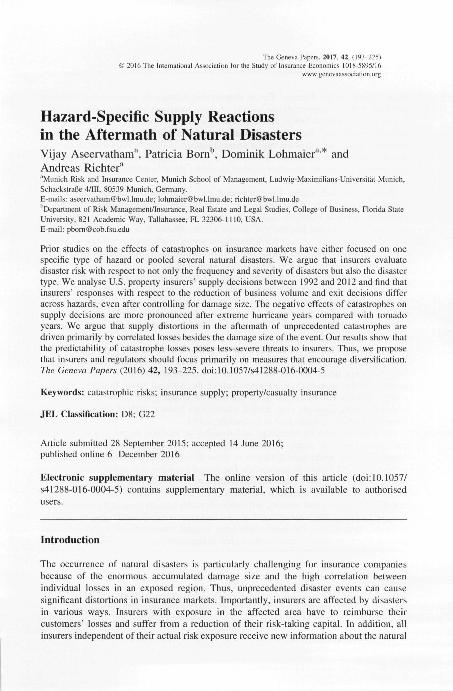Hazard-specific supply reactions in the aftermath of natural disasters

Contenido multimedia no disponible por derechos de autor o por acceso restringido. Contacte con la institución para más información.
| Tag | 1 | 2 | Valor |
|---|---|---|---|
| LDR | 00000cab a2200000 4500 | ||
| 001 | MAP20170012665 | ||
| 003 | MAP | ||
| 005 | 20170426123923.0 | ||
| 008 | 170418e20170403esp|||p |0|||b|spa d | ||
| 040 | $aMAP$bspa$dMAP | ||
| 084 | $a32 | ||
| 245 | 0 | 0 | $aHazard-specific supply reactions in the aftermath of natural disasters$cVijay Aseervatham... [et al.] |
| 520 | $aPrior studies on the effects of catastrophes on insurance markets have either focused on one specific type of hazard or pooled several natural disasters. We argue that insurers evaluate disaster risk with respect to not only the frequency and severity of disasters but also the disaster type. We analyse U.S. property insurers¿ supply decisions between 1992 and 2012 and find that insurers¿ responses with respect to the reduction of business volume and exit decisions differ across hazards, even after controlling for damage size. The negative effects of catastrophes on supply decisions are more pronounced after extreme hurricane years compared with tornado years. We argue that supply distortions in the aftermath of unprecedented catastrophes are driven primarily by correlated losses besides the damage size of the event. Our results show that the predictability of catastrophe losses poses less-severe threats to insurers. Thus, we propose that insurers and regulators should focus primarily on measures that encourage diversification. | ||
| 650 | 4 | $0MAPA20080590291$aDesastres naturales | |
| 650 | 4 | $0MAPA20080581978$aProperty-casualty | |
| 650 | 4 | $0MAPA20080600204$aCatástrofes naturales | |
| 650 | 4 | $0MAPA20080591182$aGerencia de riesgos | |
| 700 | 1 | $0MAPA20170004004$aAseervatham, Vijay | |
| 773 | 0 | $wMAP20077100215$tGeneva papers on risk and insurance : issues and practice$dGeneva : The Geneva Association, 1976-$x1018-5895$g03/04/2017 Volumen 42 Número 2 - abril 2017 , p. 193-225 |

